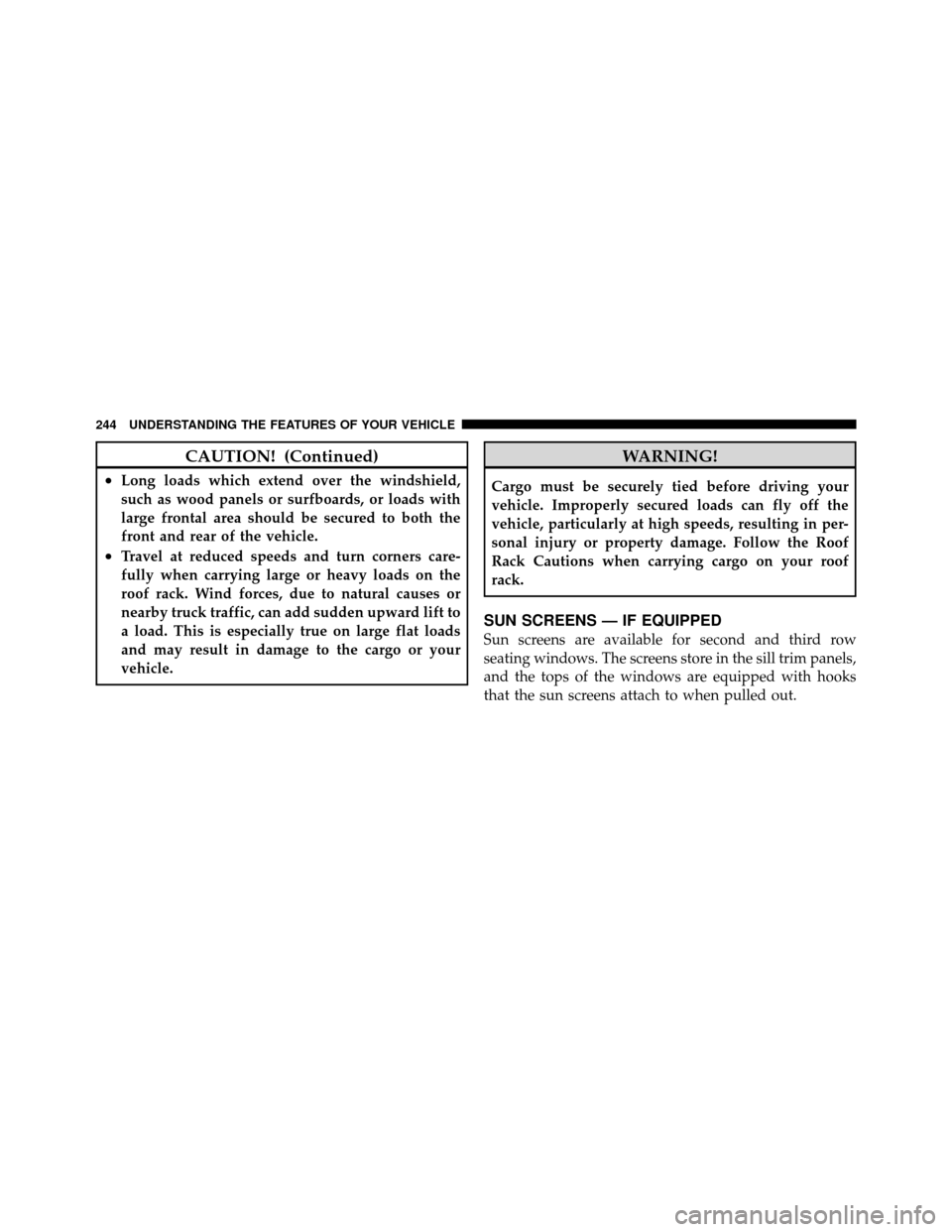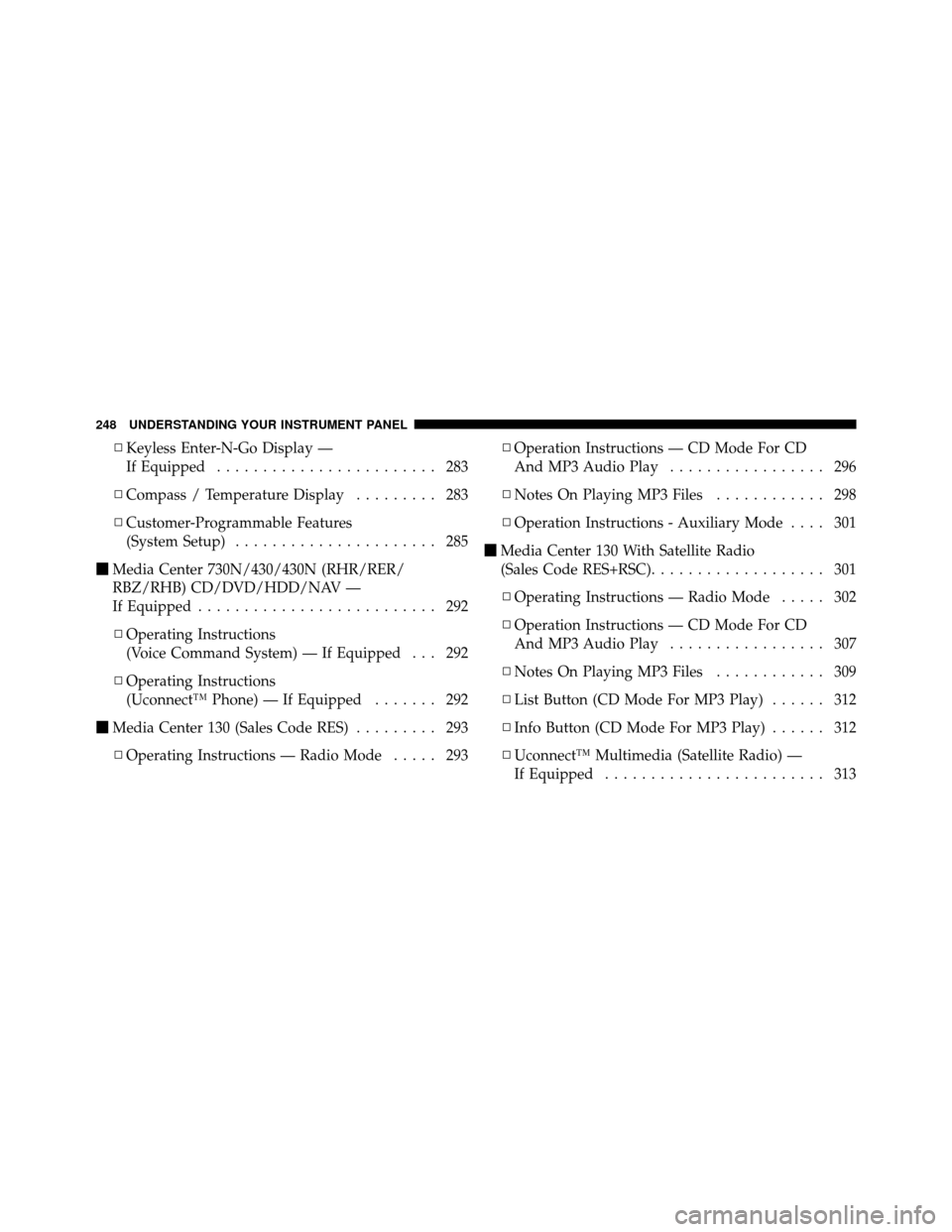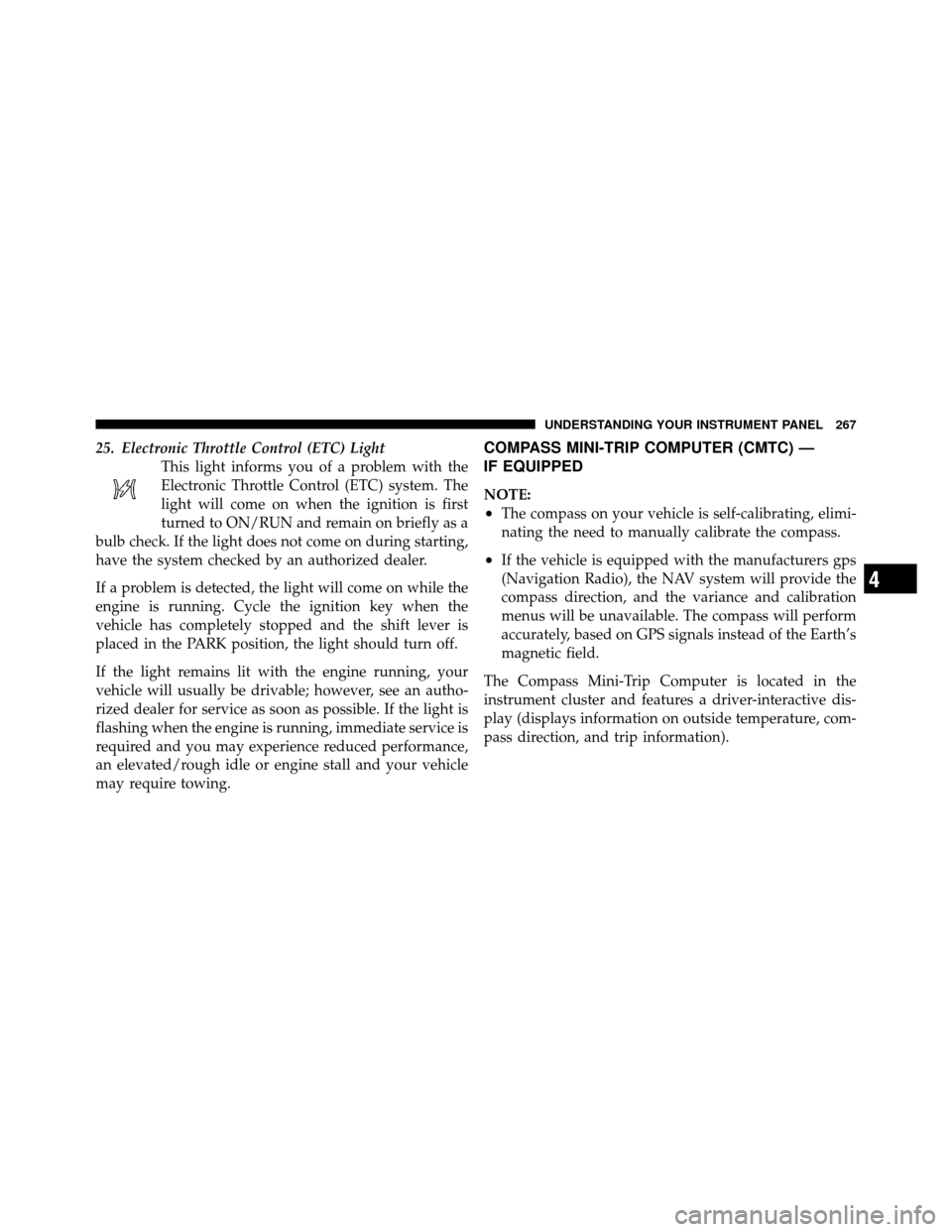Page 245 of 573
Once the crossbars are set into position, tighten the
thumb screws completely.Stowing the Crossbars
Reverse the procedure to stow the crossbars, again,
taking care to keep hand clear of pivoting joint. Crossbars
are identical and can be stowed in either rail nest. Once
the crossbars are stowed, tighten the thumb screws
completely.
NOTE:Load should always be secured to crossbars
first, with rail tie down loops used as additional securing
points if needed. Tie loops are intended as supplemen-
tary tie down points only. Do not use ratcheting mecha-
nisms with the tie loops.
Tightening Crossbar
242 UNDERSTANDING THE FEATURES OF YOUR VEHICLE
Page 246 of 573
CAUTION!
•Check deployed crossbars frequently and re-
tighten thumb screws as necessary.
•To avoid damage to the roof rack and vehicle, do
not exceed the maximum roof rack load capacity of
150 lbs (68 kg). Always distribute heavy loads as
evenly as possible and secure the load appropri-
ately.
•To prevent damage to the roof of your vehicle, DO
NOT carry any loads on the roof rack without the
crossbars deployed.
•The load should be secured and placed on top of
the crossbars, not directly on the roof. If it is
necessary to place the load on the roof, place a
blanket or other protective layer between the load
and the roof surface.(Continued)Rail Tie Loops
3
UNDERSTANDING THE FEATURES OF YOUR VEHICLE 243
Page 247 of 573

CAUTION! (Continued)
•Long loads which extend over the windshield,
such as wood panels or surfboards, or loads with
large frontal area should be secured to both the
front and rear of the vehicle.
•Travel at reduced speeds and turn corners care-
fully when carrying large or heavy loads on the
roof rack. Wind forces, due to natural causes or
nearby truck traffic, can add sudden upward lift to
a load. This is especially true on large flat loads
and may result in damage to the cargo or your
vehicle.
WARNING!
Cargo must be securely tied before driving your
vehicle. Improperly secured loads can fly off the
vehicle, particularly at high speeds, resulting in per-
sonal injury or property damage. Follow the Roof
Rack Cautions when carrying cargo on your roof
rack.
SUN SCREENS — IF EQUIPPED
Sun screens are available for second and third row
seating windows. The screens store in the sill trim panels,
and the tops of the windows are equipped with hooks
that the sun screens attach to when pulled out.
244 UNDERSTANDING THE FEATURES OF YOUR VEHICLE
Page 248 of 573
Gently pull up on the tab to raise the sun screen.
Continue pulling the sun screen until the tab is near the
top of the window.
Once the screen is completely to the top of the window,
extend the top bar of the sun screen over the two hooks
attached to the top of the window.To lower the sun screen, gently lift the tab upward to
disengage the hooks, and feed the screen back into the
base sill.
Sun Screen RetractedSun Screen Extended
3
UNDERSTANDING THE FEATURES OF YOUR VEHICLE 245
Page 250 of 573
UNDERSTANDING YOUR INSTRUMENT PANEL
CONTENTS
�Instrument Panel Features ............... 251
� Instrument Cluster — Base ............... 252
� Instrument Cluster — Premium ........... 253
� Instrument Cluster Descriptions ........... 254
� Compass Mini-Trip Computer (CMTC) —
If Equipped .......................... 267
▫ CMTC Reset Buttons .................. 268
▫ Compass/Temperature Display .......... 269�
Electronic Vehicle Information Center (EVIC) —
If Equipped .......................... 271
▫ Electronic Vehicle Information Center (EVIC)
Displays ........................... 273
▫ Fuel Economy ...................... 280
▫ Vehicle Speed ....................... 281
▫ Trip Info .......................... 281
▫ Units ............................. 282
▫ Vehicle Info
(Customer Information Features) ......... 282
4
Page 251 of 573

▫Keyless Enter-N-Go Display —
If Equipped ........................ 283
▫ Compass / Temperature Display ......... 283
▫ Customer-Programmable Features
(System Setup) ...................... 285
� Media Center 730N/430/430N (RHR/RER/
RBZ/RHB) CD/DVD/HDD/NAV —
If Equipped .......................... 292
▫ Operating Instructions
(Voice Command System) — If Equipped . . . 292
▫ Operating Instructions
(Uconnect™ Phone) — If Equipped ....... 292
� Media Center 130 (Sales Code RES) ......... 293
▫ Operating Instructions — Radio Mode ..... 293▫
Operation Instructions — CD Mode For CD
And MP3 Audio Play ................. 296
▫ Notes On Playing MP3 Files ............ 298
▫ Operation Instructions - Auxiliary Mode .... 301
� Media Center 130 With Satellite Radio
(Sales Code RES+RSC) ................... 301
▫ Operating Instructions — Radio Mode ..... 302
▫ Operation Instructions — CD Mode For CD
And MP3 Audio Play ................. 307
▫ Notes On Playing MP3 Files ............ 309
▫ List Button (CD Mode For MP3 Play) ...... 312
▫ Info Button (CD Mode For MP3 Play) ...... 312
▫ Uconnect™ Multimedia (Satellite Radio) —
If Equipped ........................ 313
248 UNDERSTANDING YOUR INSTRUMENT PANEL
Page 254 of 573
INSTRUMENT PANEL FEATURES
1 — Air Vents5 — Analog Clock 9 — DVD – If Equipped 13 — Ignition Switch
2 — Instrument Cluster 6 — Upper Glove Compartment 10 — Storage Bin 14 — Hood Release
3 — Shift Lever 7 — Lower Glove Compartment 11 — Cup Holders 15 — Dimmer Switch
4 — Radio 8 — Climate Controls 12 — Switch Bank16 — Headlight Switch
4
UNDERSTANDING YOUR INSTRUMENT PANEL 251
Page 270 of 573

25. Electronic Throttle Control (ETC) LightThis light informs you of a problem with the
Electronic Throttle Control (ETC) system. The
light will come on when the ignition is first
turned to ON/RUN and remain on briefly as a
bulb check. If the light does not come on during starting,
have the system checked by an authorized dealer.
If a problem is detected, the light will come on while the
engine is running. Cycle the ignition key when the
vehicle has completely stopped and the shift lever is
placed in the PARK position, the light should turn off.
If the light remains lit with the engine running, your
vehicle will usually be drivable; however, see an autho-
rized dealer for service as soon as possible. If the light is
flashing when the engine is running, immediate service is
required and you may experience reduced performance,
an elevated/rough idle or engine stall and your vehicle
may require towing.COMPASS MINI-TRIP COMPUTER (CMTC) —
IF EQUIPPED
NOTE:
•The compass on your vehicle is self-calibrating, elimi-
nating the need to manually calibrate the compass.
•If the vehicle is equipped with the manufacturers gps
(Navigation Radio), the NAV system will provide the
compass direction, and the variance and calibration
menus will be unavailable. The compass will perform
accurately, based on GPS signals instead of the Earth’s
magnetic field.
The Compass Mini-Trip Computer is located in the
instrument cluster and features a driver-interactive dis-
play (displays information on outside temperature, com-
pass direction, and trip information).
4
UNDERSTANDING YOUR INSTRUMENT PANEL 267